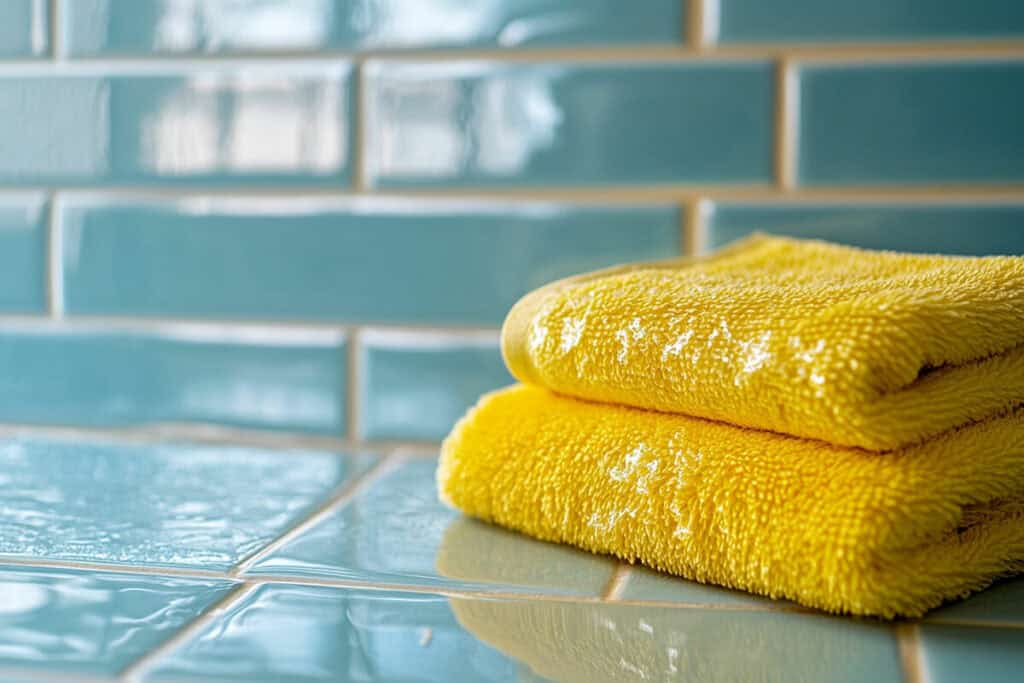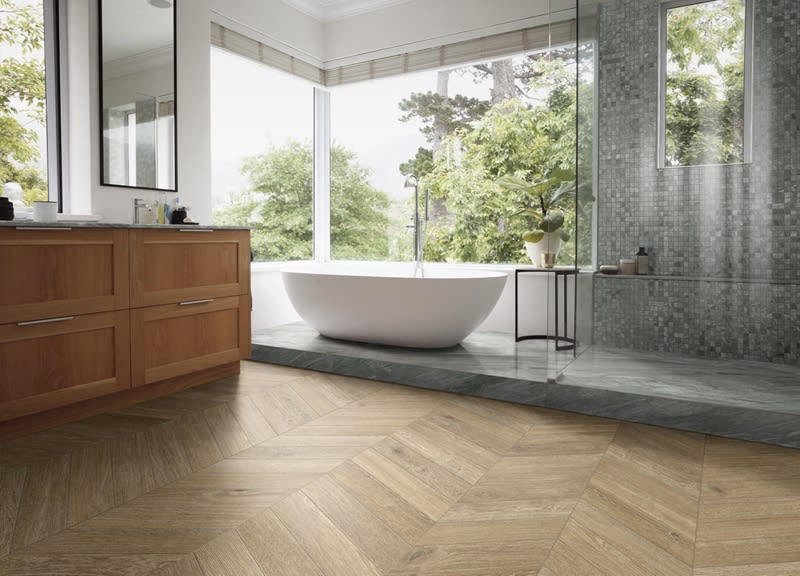Keeping your bathroom tiles clean isn’t just about appearance; it’s about maintaining a hygienic space that reduces the risk of mould and bacteria. With constant exposure to moisture and steam, bathroom tiles can quickly gather dirt and develop unsightly stains. Regular cleaning also helps prevent long-term issues, like permanent discolouration and stubborn mould growth, that become harder to treat over time.
In this guide, you’ll find clear, practical advice on cleaning different types of bathroom tiles and grout. We’ll cover specific cleaning products for each tile type to ensure you get the best results while protecting your surfaces. You’ll also learn essential tips for daily maintenance and mould prevention to keep your bathroom tiles looking fresh and clean for longer.
Table of contents:
- Essential supplies and safety tips for cleaning tiles in the bathroom
- How to clean wall tiles based on material
- How to clean floor tiles safely and effectively
Essential Supplies and Safety Tips for Cleaning Tiles in the Bathroom
Before starting to clean your bathroom tiles, gathering the right supplies is essential for safe and effective results. Using appropriate cleaning products based on your tile type not only improves cleanliness but also helps prevent accidental damage.
Recommended Supplies for cleaning:
- Microfiber cloths: ideal for wiping and drying surfaces without leaving streaks or scratches.
- Non-abrasive sponges: use a gentle sponge for scrubbing tiles to avoid scratching, especially on delicate surfaces.
- Grout brush or old toothbrush: helps reach grout lines and remove dirt build-up effectively.
- Rubber gloves: protect your hands from chemicals and reduce the risk of skin irritation.
- Cleaners for specific tiles: vinegar and baking soda are quite popular cleaners among people who don’t want to deal with chemicals. However, there are special cleaners that have been developed specifically for a particular type of tile. Such cleaners not only make it easier to remove dirt but also preserve the original appearance of the tiles. This is extremely important, because a cleaner that may work well for porcelain, can be harmful to natural stone.
Before cleaning any tile, first know what is installed in your bathroom to avoid unnecessary damage (discolouration, fading, etc).
Safety Precautions
When cleaning your bathroom tiles, it’s important to follow a few safety precautions to ensure the process is safe and effective. Start by ventilating the bathroom properly; open a window or use the exhaust fan to reduce any fumes from cleaning products. Good ventilation also helps prevent moisture from building up, which can lead to mould.
Another key precaution is to avoid mixing different cleaning agents. Combining products, especially those containing bleach and ammonia, can release harmful fumes. Stick to one cleaning product at a time, and follow the manufacturer’s instructions closely for safe use.
With these precautions and your supplies ready, you’re all set to clean your bathroom tiles safely and effectively.

How to Clean Wall Tiles Based on Material
To get the best results when cleaning bathroom wall tiles, it’s helpful to start with a simple preparation step. Run a hot shower for a few minutes before cleaning. The steam from the shower will help loosen dirt and grime, making it easier for your cleaning products to penetrate and work effectively on the tiles.
Cleaning Process by Material
Different tile materials require specific cleaning methods to ensure effective cleaning without causing damage:
- Ceramic and porcelain tiles. These tiles can generally handle standard bathroom cleaners. Choose a non-abrasive bathroom cleaner specifically safe for ceramic or porcelain tiles. Apply the cleaner to the tiles and gently wipe the surface with a sponge. There’s no need for heavy scrubbing, as the cleaner will lift most dirt with light pressure.
- Natural stone tiles (e.g., marble, granite). For stone surfaces, it’s essential to avoid acidic cleaners, which can cause etching and discolouration. Instead, use a pH-neutral cleaner specially formulated for stone tiles. Apply it with a soft cloth or sponge, taking care to avoid any abrasive tools that could scratch the surface.
- Patterned or decorative tiles. Tiles with patterns or decorative designs need a gentler approach to preserve their look. Opt for a mild cleaner and use a soft cloth to wipe the tiles carefully. Avoid scrubbing, as this can damage delicate designs over time.
After cleaning, make sure to rinse the tiles with clean water to remove any cleaner residue. Dry the tiles with a microfiber cloth to prevent streaks and water spots, keeping your bathroom walls looking fresh.

How to Clean Floor Tiles Safely and Effectively
Once your bathroom wall tiles are clean and dry, the next step is to tackle the floor tiles. Cleaning the floors after the walls ensures that any dust or residue from the wall cleaning is also removed, leaving your bathroom spotless from top to bottom.
Begin by sweeping or vacuuming the floor to remove any loose dirt and debris. This quick step prevents particles from scratching the tile surface and helps you thoroughly clean.
With the floor prepped, mop the tiles using your chosen cleaner. Use gentle, even strokes, focusing on lifting dirt without oversaturating the floor. After mopping, allow the floor to dry completely.
For a polished finish, use a microfiber cloth to remove any remaining moisture, preventing streaks or watermarks. This final touch will leave your bathroom floor looking clean and shiny.
Preventing Mould and Mildew on Tiles and Grout
After thoroughly cleaning your bathroom tiles, keeping mould and mildew at bay is essential to maintain their fresh appearance. Preventative steps make a significant difference in reducing moisture buildup, which is a key factor in mould growth.
Ventilation Tips
Good ventilation is one of the most effective ways to prevent moisture from settling on your tiles and grout. After each shower, open a window or switch on the exhaust fan to allow humid air to escape. If neither is available, simply leave the bathroom door open for a while. This helps air circulate, preventing excess moisture that can lead to mould.
Daily Maintenance
In addition to ventilation, a quick daily wipe-down can go a long way. After each shower, use a soft cloth to gently dry the tiles and grout, especially around high-moisture areas like the shower walls and floors. This simple step helps prevent water stains and keeps mould from forming, making future cleaning easier and less frequent.
By incorporating these preventive measures into your routine, you can keep your bathroom tiles and grout looking clean and fresh for longer, with less effort.

